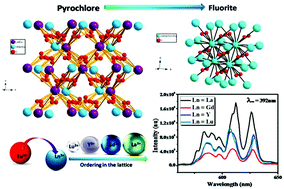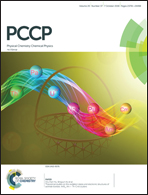Exploitation of Eu3+ red luminescence through order–disorder structural transitions in lanthanide stannate pyrochlores for warm white LED applications†
Abstract
Eu3+ ions epitomize excellent structural probes for the detection of disorder induced by structural variations in stannate pyrochlores due to their relatively simple energy level structure. In this context, we have synthesized a series of Eu3+ doped Ln2.85YSnNbO10.5:0.15Eu3+ (Ln = La, Gd, Y, and Lu) red phosphors via a high temperature solid state reaction method to explore the influence of phase evolution on the luminescence properties. The substitution of Ln3+ ions in the A sites of the pyrochlore induces a structural transition from an ordered pyrochlore to a disordered fluorite structure with decreasing ionic radius. The diminishing trend of the characteristic superstructure peaks in the XRD pattern and the broadening of Raman modes with lanthanide substitution clearly substantiate the disorder induced in the cationic sublattice. These phosphors exhibit strong absorption in the near UV region and emit red luminescence under 392 nm excitation, which also correlates to their crystal structures. Their luminescence properties were enhanced with the increased ordering of cations from Lu to La. The more ordered structure of the La system favors a more uniform distribution of Eu3+ ions, preventing cluster formation, and thus improving the luminescence properties. The splitting of the 5D0–7F1 transition of the Eu3+ ions further provides a clue for the structural transition in support of the XRD and Raman analysis. The long range ordering, ligand polarizability, and covalent nature of the Eu3+ bonding influence the emission probability and improve the quantum efficiency of the La host. Eu3+ emissions resulting from 5D0–7FJ transitions are significantly improved with increases in the concentration of Eu3+ ions in the La host. The distortion of the A site symmetry and the red shift of the charge transfer band with Eu3+ doping in the La3YSnNbO10.5 system leads to an enhanced electric dipole transition. The extent of the distortion in the EuO8 polyhedra is reflected in the quantum efficiency values and J–O intensity parameters, Ω2 and Ω4, which are a measure of the degree of polarizability of the Eu–O bonds in the lattice. Our results suggest that we can manipulate the Eu3+ red luminescence in lanthanide stannate pyrochlores through order–disorder structural transitions.



 Please wait while we load your content...
Please wait while we load your content...